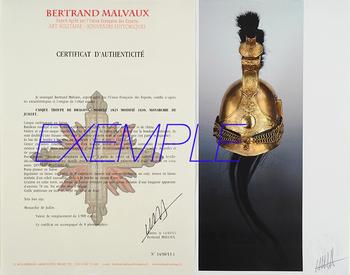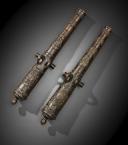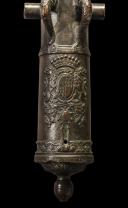
Pair of cannons, "La Frayeur" and "Le Vengeur", cast by Maritz in Lyon in 1737, in the Ancient Monarchy era, reign of Louis XV. From the Philippe Missillier collection, to be auctioned by Giquello at Drouot - rooms 5-6, on March 6th & 7th, 2025.
Sold out
COLLECTION PHILIPPE MISSILLIER
HIGH PERIOD - BOOKS - 17TH CENTURY FIREARMS
HUNTING ART - PHALERISTICS
18TH AND 19TH CENTURY WEAPONS - RUSSIAN ART
Friday, March 7, 2025 - 11am to 12pm
AFRICA AND OCEANIA - FAR EAST
Friday, March 7, 2025 - 2pm
ISLAMIC AND INDIAN ART
Drouot - rooms 5-6
EXHIBITION
Tuesday, March 4, from 11am to 6pm
Wednesday, March 5, from 11am to 6pm
Thursday, March 6, from 11am to 12pm
Phone during the exhibition +33(0)1 48 00 20 05
GIQUELLO
Alexandre Giquello
Violette Stcherbatcheff
5, rue La Boétie - 75008 Paris
+33 (0)1 47 42 78 01 - info@giquello.net
For approval
Lot No. 2002 389
CONTACT
Claire Richon
+33(0)1 47 70 48 00
c.richon@giquello.net
EXPERT
Bertrand Malvaux, CNES
Lot No. 189 (from the sale)
Pair of cannons, "La Frayeur" and "Le Vengeur", cast by Maritz in Lyon in 1737, Old Monarchy, reign of Louis XV.
In bronze, decorated with the arms of Camille Perrichon: under a crown flanked by two rampant lions, in a collar of the Order of Saint-Michel: quartered, with a plain golden 1 and 4, varied with silver and gules at 2 and 3; with a border composed of silver and gules. Marked on the base "Lyon 1737 Maritz Commre des Fontes de France", with a pelican feeding its young from its entrails, surmounted by the motto "Se Dat / omnibus / Ultro", one bearing the name "Le Vengeur", the second "La Frayeur". Handles shaped like dolphins.
Length: 75 cm; Mouth diameter: 3 cm.
France.
Old Monarchy, reign of Louis XV.
Very good condition.
10000/15000
Biography: Camille Perrichon, born on February 8, 1678 in Lyon and died on May 7, 1768 in Lyon, was a Lyonnais politician and member of the Academy of Sciences, Literature, and Arts of Lyon. Admitted to the Order of Saint-Michel in 1720 according to the almanacs, where he is mentioned from 1722 to 1769. Another member of this family was named in the order in 1727.
The armorial of bibliophiles from Lyon, Forez, Beaujolais, and Dombes by W. Poidebard, J. Baudrier, and L. Galle, in Lyon at the headquarters of the Société Maison Palais Royal, No. 2, rue du Plat MDCCCCVII, provides the following biography:
Born in 1678, knight, secretary of the city of Lyon, provost of the merchants and commander of the said city in the absence of Monseigneur the Duke of Villeroy, from 1730 to 1739, knight of the king's order, ordinary councilor of state, member of the Academy of Fine Arts of Lyon, married on April 10, 1701, contract received by Delalay, notary, to Suzanne Ollivier, daughter of David Ollivier, former alderman, and Françoise Arezon. From this union he had: 1) Françoise, married on February 15, 1721, contract received by Perrin, to Christophe de la Frasse, councilor at the presidial and chief of police in Lyon, son of Claude de la Frasse, treasurer of France, lord of Seynas, and Marie Ravachol; 2) Françoise-Suzanne, baptized at Saint-Saturnin on October 3, 1702, married on March 4, 1719, contract received by Perrin, to Antoine-Joseph Boesse, knight of Saint-Louis, captain in the Lyonnais regiment, son of the late Christophe Boesse, knight, treasurer of France, and Catherine Pecoil; 3) David, baptized on January 21, 1703; 4) Suzanne, baptized on January 16, 1706.
Michon, author of the Journal de Lyon that one would do well to consult about Camille Perrichon, expresses his nomination as provost of the merchants as follows: "The nomination of Mr. Perrichon surprised no one and it was quite publicly said that if Mr. Dugas was not continued as provost of the merchants it would be him who would fill this position. He deserved it due to his intimate attachment for several years to Marshal de Villeroy and all his household, his understanding of the City's affairs, his care and application to manage them, and it was natural that the marshal, his master, showed him affection and gratitude. This is also all Mr. Perrichon could hope for, who should consider this position as the limit of his ambition and that of all other citizens who, like him, were born in a very modest state of fortune and birth." It should be added that Camille Perrichon, during his long provostship, attracted a lot of animosity and was very unpopular. Nevertheless, his administration was skillful and very profitable for Lyon, which he embellished, and for the silk trade that he helped develop. Rousseau, in his Confessions, expresses himself about him: "I met again the noble and generous Perrichon, and it was not without feeling his usual magnificence, as he even gave me a gift he had previously given to the kind Bernard, defraying my costs for my place on the stagecoach." He was buried on May 7, 1768, at the parish of Saint-Saturnin, at the age of 90, having "spent the days of an honorable old age in the enjoyment of rest and public esteem," says Bollioud-Mermets.
HIGH PERIOD - BOOKS - 17TH CENTURY FIREARMS
HUNTING ART - PHALERISTICS
18TH AND 19TH CENTURY WEAPONS - RUSSIAN ART
Friday, March 7, 2025 - 11am to 12pm
AFRICA AND OCEANIA - FAR EAST
Friday, March 7, 2025 - 2pm
ISLAMIC AND INDIAN ART
Drouot - rooms 5-6
EXHIBITION
Tuesday, March 4, from 11am to 6pm
Wednesday, March 5, from 11am to 6pm
Thursday, March 6, from 11am to 12pm
Phone during the exhibition +33(0)1 48 00 20 05
GIQUELLO
Alexandre Giquello
Violette Stcherbatcheff
5, rue La Boétie - 75008 Paris
+33 (0)1 47 42 78 01 - info@giquello.net
For approval
Lot No. 2002 389
CONTACT
Claire Richon
+33(0)1 47 70 48 00
c.richon@giquello.net
EXPERT
Bertrand Malvaux, CNES
Lot No. 189 (from the sale)
Pair of cannons, "La Frayeur" and "Le Vengeur", cast by Maritz in Lyon in 1737, Old Monarchy, reign of Louis XV.
In bronze, decorated with the arms of Camille Perrichon: under a crown flanked by two rampant lions, in a collar of the Order of Saint-Michel: quartered, with a plain golden 1 and 4, varied with silver and gules at 2 and 3; with a border composed of silver and gules. Marked on the base "Lyon 1737 Maritz Commre des Fontes de France", with a pelican feeding its young from its entrails, surmounted by the motto "Se Dat / omnibus / Ultro", one bearing the name "Le Vengeur", the second "La Frayeur". Handles shaped like dolphins.
Length: 75 cm; Mouth diameter: 3 cm.
France.
Old Monarchy, reign of Louis XV.
Very good condition.
10000/15000
Biography: Camille Perrichon, born on February 8, 1678 in Lyon and died on May 7, 1768 in Lyon, was a Lyonnais politician and member of the Academy of Sciences, Literature, and Arts of Lyon. Admitted to the Order of Saint-Michel in 1720 according to the almanacs, where he is mentioned from 1722 to 1769. Another member of this family was named in the order in 1727.
The armorial of bibliophiles from Lyon, Forez, Beaujolais, and Dombes by W. Poidebard, J. Baudrier, and L. Galle, in Lyon at the headquarters of the Société Maison Palais Royal, No. 2, rue du Plat MDCCCCVII, provides the following biography:
Born in 1678, knight, secretary of the city of Lyon, provost of the merchants and commander of the said city in the absence of Monseigneur the Duke of Villeroy, from 1730 to 1739, knight of the king's order, ordinary councilor of state, member of the Academy of Fine Arts of Lyon, married on April 10, 1701, contract received by Delalay, notary, to Suzanne Ollivier, daughter of David Ollivier, former alderman, and Françoise Arezon. From this union he had: 1) Françoise, married on February 15, 1721, contract received by Perrin, to Christophe de la Frasse, councilor at the presidial and chief of police in Lyon, son of Claude de la Frasse, treasurer of France, lord of Seynas, and Marie Ravachol; 2) Françoise-Suzanne, baptized at Saint-Saturnin on October 3, 1702, married on March 4, 1719, contract received by Perrin, to Antoine-Joseph Boesse, knight of Saint-Louis, captain in the Lyonnais regiment, son of the late Christophe Boesse, knight, treasurer of France, and Catherine Pecoil; 3) David, baptized on January 21, 1703; 4) Suzanne, baptized on January 16, 1706.
Michon, author of the Journal de Lyon that one would do well to consult about Camille Perrichon, expresses his nomination as provost of the merchants as follows: "The nomination of Mr. Perrichon surprised no one and it was quite publicly said that if Mr. Dugas was not continued as provost of the merchants it would be him who would fill this position. He deserved it due to his intimate attachment for several years to Marshal de Villeroy and all his household, his understanding of the City's affairs, his care and application to manage them, and it was natural that the marshal, his master, showed him affection and gratitude. This is also all Mr. Perrichon could hope for, who should consider this position as the limit of his ambition and that of all other citizens who, like him, were born in a very modest state of fortune and birth." It should be added that Camille Perrichon, during his long provostship, attracted a lot of animosity and was very unpopular. Nevertheless, his administration was skillful and very profitable for Lyon, which he embellished, and for the silk trade that he helped develop. Rousseau, in his Confessions, expresses himself about him: "I met again the noble and generous Perrichon, and it was not without feeling his usual magnificence, as he even gave me a gift he had previously given to the kind Bernard, defraying my costs for my place on the stagecoach." He was buried on May 7, 1768, at the parish of Saint-Saturnin, at the age of 90, having "spent the days of an honorable old age in the enjoyment of rest and public esteem," says Bollioud-Mermets.
Reference :
Étude Giquello, Drouot - salles 5-6, les 6 & 7 mars 2025

Next update Friday, april 4th at 1:30 PM
FOR ALL PURCHASES, PAYMENT IN MULTIPLE CHECKS POSSIBLE
bertrand.malvaux@wanadoo.fr 06 07 75 74 63
An authenticity certificate of the item including the description published on the site, the period, the sale price, accompanied by one or more color photographs is automatically provided for any item priced over 130 euros. Below this price, each certificate is charged 5 euros.
Only items sold by me are subject to an authenticity certificate, I do not provide any expert reports for items sold by third parties (colleagues or collectors).

